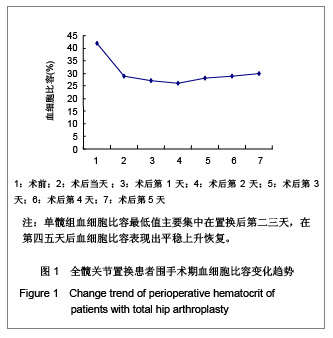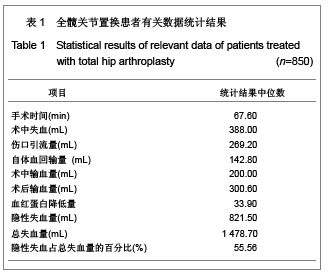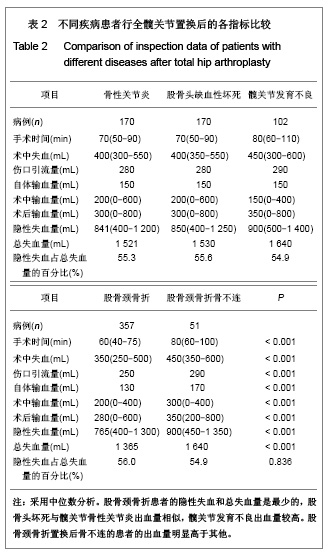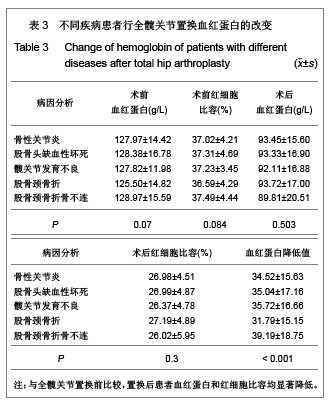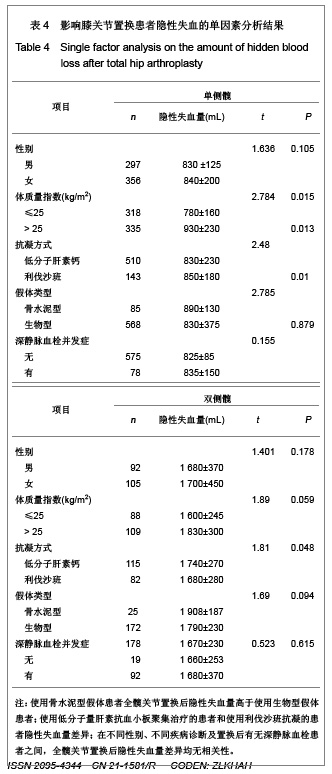| [1] Mi PH, Xia RF, Zhang SL, et al. Neimenggu Yixue Zazhi. 2012;44(5):631-633. 米培华,夏润福,张淑莲,等.循证护理在DDH行人工全髋关节置换术后预防并发症中的应用[J].内蒙古医学杂志,2012,44(5): 631-633.[2] Eriksson BI, Dahl OE, Btiller HR, et al. A new oral direct throm- bin inhibitor, dabigatran etexilate, compared with enoxaparin for prevention of thromboembolic events following total hip or knee re- placement: the BISTRO II randomized trial. J Thromb Haem-ost. 2005;3(1):103-111.[3] Zhao DF, Liu XW, Wang JS, et al. Linchuang Junyi Zazhi. 2012;40(4):861-864. 赵东风,刘欣伟,王俊生,等.双侧同时初次人工全髋关节置换术显性失血和隐性失血的分析[J].临床军医杂志,2012,40(4): 861-864.[4] Gao YL, Wang DC, Li PJ, et al. SHiyong Yiyao Zaazhi. 2012; 29(6):490-492. 高玉镭,王东辰,李佩佳,等.人工全髋关节置换术隐性失血量的估算及原因分析[J].实用医药杂志,2012,29(6):490-492.[5] Chen LL, Wang WC, Mao XZ, et al. Zhongnan Daxue Xuebao (Yixueban). 2007;32(2):316-319. 陈良龙,王万春,毛新展,等.老龄患者全髋膝关节置换术失血量的及时评估和处理[J].中南大学学报(医学版),2007,32(2):316- 319.[6] Chen LL, Wang WC, Mao XZ, et al. Evaluation and treatment of hemorrhage after hip and knee arthroplasty in the aged. Zhong Nan Da Xue Xue Bao Yi Xue Ban. 2007;32(2):316- 319. [7] Xiao P, Wu XJ, Liu HJ. Zhongguo Zuzhi Gongcheng Yanjiu yu Linchuang Kangfu.2008;12(4):635-638. 肖鹏,吴学建,刘宏建.人工关节置换术后隐性失血的相关分析[J]. 中国组织工程研究与临床康复,2008,12(4):635-638.[8] McManus KT, Velchik MG, Alavi A, et al.Non-invasive assessment of postoperative bleeding in TKA patients witIl Tc-99m RNCs. J Nuclear Med.1987;28:565-567.[9] Cong Y, Zhao JN. Yixue Yanjiusheng Xuebao. 2010;23(12): 1332-1336. 丛宇,赵建宁.人工关节置换术后失血的相关研究[J].医学研究生学报,2010,23(12):1332-1336.[10] Li L, Sun B, Liu SL. Zhongyi Zhenggu.2012;24(1):40-42. 李禄,孙波,刘世珑.全髋关节置换及全膝关节置换术后隐性失血的研究进展[J].中医正骨,2012,24(1):40-42.[11] Zhou YX. Zhongguo Weisheng Biaozhun Guanli. 2011;2(04): 72-74. 周一新.骨科标准新突破 手术技术指导规范-《人工髋、膝关节置换术》解读[J].中国卫生标准管理,2011,2(04):72-74.[12] Li QZ. Zhongguo Zuzhi Gongcheng Yanjiu yu Linchuang Kangfu. 2007,11(34):6845-6848. 李奇志. 骨水泥型与非骨水泥型假体的置换应用特征[J].中国组织工程研究与临床康复,2007,11(34):6845-6848.[13] Yang PY, Sun JY. Sunzhou Daxue. 2006. 杨沛彦,孙俊英. 股骨近端形态与锥形柄全髋生物学固定的相关研究[D]. 苏州大学,2006.[14] Sehat KR, Evans RL, Newman JH. Hidden blood loss following hip and knee arthroplasty. Correct management of blood loss should take hidden loss into account. J Bone Joint Surg Br. 2004;86(4):561-565.[15] Ward CF, Alfery DD, Benumof JL. Hypertension following nitroprusside. Anesthesiology. 1980;52(6):525-526.[16] Gross JB. Estimating allowable blood loss: corrected for dilution. Anesthesiology. 1983;58(3):277-280.[17] Nadler SB, Hidalgo JH, Bloch T. Prediction of blood volume in normal human adults. Surgery. 1962;51(2):224-232.[18] Foss NB, Kehlet H. Hidden blood loss after surgery for hip fracture. J Bone Joint Surg Br. 2006;88(8):1053-1059.[19] Pattison E, Protheroe K, Pringle RM, et al. Reduction in haemoglobin after knee joint surgery. Ann Rheum Dis. 1973; 32(6):582-584.[20] Erskine JG, Fraser C, Simpson R, et al. Blood loss with knee joint replacement. J R Coll Surg Edinb. 1981;26(5):295-297.[21] Xu H, Wang YZ. Qingdao Daxue. 2009. 徐浩,王英振. 全膝关节置换术隐性失血及其危险因素研究[D].青岛大学,2009.[22] Liu XD, Zhang XL, Zeng BF, et al. Zhonguo Jiaoxing Waike Zazhi. 2011;19(12):995-997. 刘旭东,张先龙,曾炳芳,等. 全髋关节置换术后的隐性失血分析[J]. 中国矫形外科杂志,2011,19(12):995-997. [23] Qiu QS, Chen DY, Xu ZH, et al. Shiyong Guke Zazhi. 2012; 18(6):510-512. 邱旭升,陈东阳,徐志宏,等.全膝关节置换术后隐性失血危险因素的分析[J]. 实用骨科杂志,2012,18(6):510-512.[24] Wang ZY, Zhou JS, Li ZC, et al. Jiepou yu Linchuang. 2012; 17(4):288-291. 王志岩,周建生,李昭程,等.人工髋关节置换术后并发有症状下肢深静脉血栓临床分析[J].解剖与临床,2012,17(4):288-291.[25] Zhang C, Li M, Wang KZ, et al. Zhonghua Guanjie Waike Zazhi(Dianziban). 2012;6(4):12-15. 张晨,李苗,王坤正,等. 彩色多普勒超声检查联合超声弹性成像对初次全髋关节置换术后下肢深静脉血栓形成的分期诊断价值[J].中华关节外科杂志(电子版),2012,6(4):12-15.[26] Liu J, Shen F, Huang JH, et al. Kunming Yixueyuan Xueyuan. 2012;33(7):84-87. 刘军,沈飞,黄际河,等.全髋关节置换术后深静脉血栓形成的危险因素分析[J].昆明医学院学报,2012,33(7):84-87.[27] Li M, Wang ZP. Xuzhou Yiyuan Xuebao. 2012;32(3):158-161. 李明,王志萍.术前应用低分子肝素对老年人工髋关节置换术后下肢深静脉血栓的预防作用[J].徐州医学院学报,2012,32(3): 158-161.[28] Bell TH, Berta D, Ralley F, et al. Factors affecting perioperative blood loss and transfusion rates in primary total joint arthroplasty: a prospective analysis of 1642 patients. Can J Surg. 2009;52(4):295-301.[29] Chen LL,Wang WC,Mao XZ,et al. Zhongnan Daxue Xuebao (Yixueban).2007;32(2):316-319. 陈良龙,王万春,毛新展,等.老龄患者全髋膝关节置换术失血量的及时评估和处理[J].中南大学学报(医学版),2007,32(2): 316-319.[30] Aktas E, Kaya AV, Deveci MA, et al. Polysaccharide hemostatic system reduces blood loss in high-body-mass-index patients undergoing simultaneous bilateral total knee arthroplasty. J Orthop Sci. 2012;17(4): 432-436.[31] Gao FQ, LI ZJ, Zhan K, et al. Zhonghua Guke Zazhi. 2011; 45(5):419-423. 高福强,李子剑,张克,等.初次全膝关节置换术后隐形失血的影响的因素研究[J].中华骨科杂志,2011,45(5):419-423.[32] Durasek J, Dovzak-Bajs I, Sari? V. Factors affecting blood loss in total knee arthroplasty patients. Acta Med Croatica. 2010 Jul;64(3):209-214.[33] Friedman RJ, Gallus AS, Cushner FD, et al. Physician compliance with guidelines for deep-vein thrombosis prevention in total hip and knee arthroplasty. Curr Med Res Opin. 2008;24(1):87-97.[34] Wein L, Wein S, Haas SJ, et al. Pharmacological venous throm- boembolism prophylaxis in hospitalized medical patients: a meta - analysis of randomized controlled trials. Arch Intern Med. 2007;167(14):1476-1486.[35] Nordstrom BL, Kachroo S, Fraeman KH, et al. Warfarin prophylaxis in patients after total knee or hip arthroplasty--international normalized ratio patterns and venous thromboembolism. Curr Med Res Opin. 2011;27(10): 1973-1985.[36] Li J, ZHou Y, Xing YH, et al. Zhongguo Xiufu Chongjian Waike Zazhi. 2013;26(4):87-89. 李军,周云,荆珏华,等.两种抗凝药物对人工全髋关节置换术隐性失血的影响比较[J].中国修复重建外科杂志,2013,26(4):87-89.[37] Gao CL, Wu WY, Wei JD, et al. Xiandai Zhongxiyi Jiehe Zazhi. 2013;21(7):104-106. 高乐才,吴文元,魏金栋,等.利伐沙班与低分子肝素对髋、膝关节置换术后隐性失血影响的对比观察[J].现代中西医结合杂志, 2013,21(7):104-106.[38] Fu Z, Zhang J, Yao H, et al. Chongqing Yike Daxue Xuebao. 2012,37(4):359-361. 傅峥,张健,姚海,等. 氨甲环酸对全髋关节置换术隐性失血的影响[J]. 重庆医科大学学报,2012,37(4):359-361. [39] Xu J, Ma RF, Li LP, et al. Zhongguo Zuzhi Gongcheng Yanjiu. 2012;16(48):8963-8967. 许杰,马若凡,李亮平,等.应用低分子肝素对初次全髋及全膝关节置换后失血的影响[J].中国组织工程研究,2012,16(48): 8963-8967. [40] Wang GD, Zhang YM, Zhao XW, et al. 2012;26(11):1306- 1309. 王国栋,张元民,赵晓伟,等.利伐沙班对初次行人工全膝关节置换术后隐性失血及输血率的影响[J].中国修复重建外科杂志,2012, 26(11):1306-1309.[41] Gao FQ, Li ZJ, Zhang K, et al. Zhonguo Xiufu Chongjian Waike Zazhi. 2011;25(4):393-396. 高福强,李子剑,张克,等.低分子肝素对初次人工全膝关节置换术后隐性失血与输血率的影响[J].中国修复重建外科杂志,2011, 25(4):393-396. |
